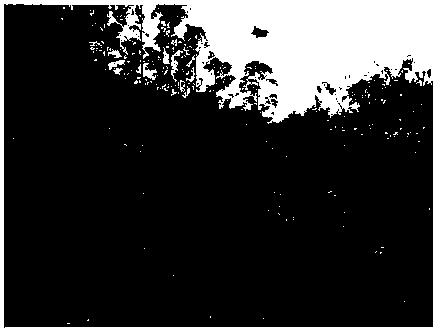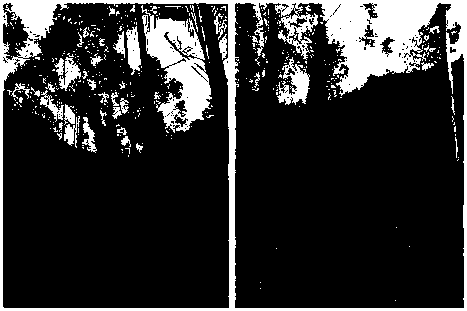Method of controlling harms of mikania micrantha by allelopathy of local plants
A technology of Mikania micrantha and plants is applied in the field of controlling the harm of Mikania micrantha, which can solve the problems of uncontrollable re-invasion and harm of Mikania micrantha seeds, no repeatability, low reference value, etc., and achieves the effects of low cost, easy survival, and prevention of invasion and harm.
- Summary
- Abstract
- Description
- Claims
- Application Information
AI Technical Summary
Problems solved by technology
Method used
Image
Examples
Embodiment 1
[0038] This example takes Mikania micrantha invaded woodland in Zengcheng District, Guangzhou City as an example to illustrate the present invention in detail.
[0039] 1. Experimental site background
[0040] Guangzhou Zengcheng suffered from the invasion of the exotic plant Mikania micrantha, and the damage was very serious. The inventors conducted an investigation on the invasive plant Mikania micrantha in the forestland of Zengcheng, Guangzhou in 2014, and found that the serious invasion of Mikania mikania mainly included eucalyptus forests, litchi and citrus orchards. , The forest ecosystem was severely damaged by Mikania micrantha.
[0041] 2. Experimental steps
[0042] In 2015, in the survey area, 30 acres were selected to implement ecological control. The steps are as follows:
[0043] S1. Manually remove the invasive alien plant Mikania micrantha and dead trees and shrubs, and retain the native plants (including trees, shrubs and herbs) that survive in the woodland;
[0044] S...
Embodiment 2
[0050] This example takes the transformation process of Mikania micrantha invaded eucalyptus forest in Zengcheng District, Guangzhou City as an example to illustrate the present invention in detail.
[0051] 1. Experimental steps
[0052] In 2015, a 50 acre area was selected to implement the technical ecological control of the present invention in the eucalyptus forest reconstruction land in Zengcheng, Guangzhou, and the steps are as follows:
[0053] S1. After cutting down the eucalyptus, manually remove Mikania micrantha and other invasive plants, as well as dead trees and shrubs, and retain other native trees in the woodland;
[0054] S2. Vegetation reconstruction: After completing step S1, randomly mixed planting tree with arborvitae and Porphyratum at a ratio of 4:1. The saplings of Acer truncatum and Tung tree saplings are 80cm high seedlings, which are planted in a row spacing of 2.5-3m and a plant spacing of 2.5-3m to form two species-spaced planting blocks, which are combined...
Embodiment 3
[0060] 1. Experimental steps
[0061] In step S2 of Example 2, the millennium paulownia and Porphyllum vulgare were randomly mixed and planted in a ratio of 1:4, and the millennium vulgare and the millennium paulownia seedlings were bag seedlings with a height of 80 cm respectively, and the rest of the steps remained unchanged.
[0062] 2. Experimental results
PUM
 Login to View More
Login to View More Abstract
Description
Claims
Application Information
 Login to View More
Login to View More - R&D
- Intellectual Property
- Life Sciences
- Materials
- Tech Scout
- Unparalleled Data Quality
- Higher Quality Content
- 60% Fewer Hallucinations
Browse by: Latest US Patents, China's latest patents, Technical Efficacy Thesaurus, Application Domain, Technology Topic, Popular Technical Reports.
© 2025 PatSnap. All rights reserved.Legal|Privacy policy|Modern Slavery Act Transparency Statement|Sitemap|About US| Contact US: help@patsnap.com



